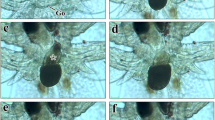Abstract
The present study reports the early effect of exogenously applied retinoic acid (RA) on embryos of the Japanese medaka, Oryzias latipes. Furthermore, as not much is known about early medaka development, a morphological description of control embryos is given and compared with well studied early cyprinid development. In medaka embryos epiboly and convergence roughly start at the same stage. Gastrulation, resulting in an outer epiblast and an inner hypoblast layer, is observed from about 25% epiboly onwards and is restricted to the dorsal side, since at that stage converging cells are already located relatively dorsally. RA treatment leads, in a stage- and dose-dependent way, to a shortening of the embryonic axis. This may be caused by a complete or partial failure of extension movements which may occur during convergence. Convergence and gastrulation appear to be, at least partly, unaffected by RA since the embryo proper is located dorsally and consists of two separate germ layers. Observation of medaka embryos until 4 days post fertilization (dpf) revealed that RA treatment caused poorly developed anterior structures (eyes, brain, heart, blood vessels). However, pectoral fins and melanin granules were always present.
Similar content being viewed by others
References
Betchaku T, Trinkaus JP (1978) Contact relations, surface activity and cortical microfilaments of marginal cells of the enveloping layer and of the yolk syncytial and yolk cytoplasmic layers of Fundulus before and during epiboly. J Exp Zool 206:381–426
Brockes J (1991) We may not have a morphogen. Nature 350:15
Cho KWJ, DeRobertis EM (1990) Differential activation of Xenopus homeobox genes by mesoderm-inducing growth factors and retinoic acid. Genes Dev 4:1910–1916
Durston AJ, Timmermans JPM, Hage WJ, Hendriks HFJ, De Vries NJ, Heideveld M, Nieuwkoop PD (1989) Retinoic acid causes an anteroposterior transformation in the central nervous system. Nature 340:140–144
Eichele G, Thaller C (1987) Characterization of concentration gradients of a morphogenetically active retinoid in the chick limb bud. J Cell Biol 105:1917–1923
Gamo H, Terajima I (1963) The normal stages of embryonic development of the medaka, Oryzias latipes. Jpn J Ichthyol 10:31–38
Gevers P, Timmermans LPM (1991) Dye-coupling and the formation and fate of the hypoblast in the teleost fish embryo, Barbus conchonius. Development 112:431–438
Gevers P, Dulos J, Boogaart JGM van den, Timmermans LPM (1992) A study on cell lineages, especially the germ cell line, in embryos of the teleost fish, Barbus conchonius. Roux's Arch Dev Biol 201:275–283
Gevers P, Coenen AJM, Schipper H, Stroband HWJ, Timmermans LPM (1993) Involvement of fibronectin during epiboly and gastrulation in embryos of the common carp, Cyprinus carpio. Roux's Arch Dev Biol 202:152–158
Haarlem R van (1981) Cell behaviour during early development of annual fishes. Thesis, Catholic University Nijmegen, The Netherlands
Holder N, Hill J (1991) Retinoic acid modifies development of the midbrain-hindbrain border and affects cranial ganglion formation in zebrafish embryos. Development 113:1159–1170
Kageyama T (1977) Motility and locomotion of embryonic cells of the medaka, Oryzias latipes, during early development. Dev Growth Differ 19:103–110
Kimmel CB, Law RM (1985a) Cell lineages of zebrafish blastomeres. I. Cleavage pattern and cytoplasmic bridges between cells. Dev Biol 108:78–85
Kimmel CB, Law RM (1985b) Cell lineage of zebrafish blastomeres. II. Formation of the yolk syncytial layer. Dev Biol 108:86–93
Kimmel CB, Warga RM (1987) Indeterminate cell lineage of the zebrafish embryo. Dev Biol 124:269–280
Kimmel CB, Warga RM, Schilling TF (1990) Origin and organization of the zebrafish fate map. Development 108:581–594
Lesseps RJ, Geurts van Kessel AHM, Denucé JM (1975) Cell patterns and cell movements during early development of an annual fish Nothobranchius neumanni. J Exp Zool 193:137–146
Mitrani E, Shimoni Y (1989) Retinoic acid inhibits growth in agarose of early chick embryonic cells and may be involved in the regulation of axis formation. Development 107:275–280
Papalopulu N, Clarke JDW, Bradley L, Wilkinson D, Krumlauf R, Holder N (1991) Retinoic acid causes abnormal development and segmental patterning of the anterior hindbrain in Xenopus embryos. Development 113:1145–1158
Ruiz i Altaba A, Jessell TM (1991) Retinoic acid modifies mesodermal patterning in early Xenopus embryos. Genes Dev 5:175–187
Sive HL, Cheng PF (1991) Retinoic acid perturbs the expression of Xhox. lab genes and alters mesodermal determination in Xenopus laevis. Genes Dev 5:1321–1332
Sive HL, Draper BW, Harland RM, Weintraub H (1990) Identification of a retinoic acid sensitive period during primary axis formation in Xenopus laevis. Genes Dev 4:932–942
Slack JMW (1987) We have a morphogen! Nature 327:553–554
Stainier DYR, Fishman MC (1992) Patterning of the zebrafish heart tube: acquisition of anteroposterior polarity. Dev Biol 153:91–101
Thaller C, Eichele G (1987) Identification of spatial distribution of retinoids in the developing chick wing bud. Nature 327:625–628
Tickle C, Alberts B, Wolpert L, Lee J (1982) Local application of retinoic acid to the limb bud mimics the action of the polarizing region. Nature 296:564–566
Trinkaus JP, Trinkaus M, Fink RD (1992) On the convergent cell movements of gastrulation in Fundulus. J Exp Zool 261:40–61
Warga RM, Kimmel CB (1990) Cell movements during epiboly and gastrulation in the zebrafish. Development 108:569–580
Wolpert L (1969) Positional information and the spatial patterning of cellular differentiation. J Theor Biol 25:1–47
Author information
Authors and Affiliations
Additional information
Correspondence to: J.M. Denuce
Rights and permissions
About this article
Cite this article
Gevers, P., Denuce, J.M. Effects of retinoic acid on epiboly, convergence and gastrulation of embryos of the medaka, Oryzias latipes (Teleostei, Cyprinodontidae). Roux's Arch Dev Biol 203, 169–174 (1993). https://doi.org/10.1007/BF00365057
Revised:
Issue Date:
DOI: https://doi.org/10.1007/BF00365057




